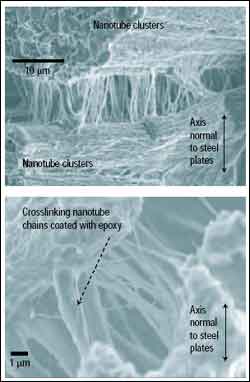Carbon Nanotube "Shock Absorbers" Excel At Dampening Vibration

This image shows clusters of the carbon-nanotube vibration-dampening material. Credit: Nikhil Koratkar, Rensselaer Polytechnic Institute. Image for media use only.
Researchers at Rensselaer Polytechnic Institute have developed a novel carbon-nanotube-based material that chokes vibration and may have applications for both large and small devices.
In the January 9, 2004, advance online edition of Nature Materials, the researchers describe the new material and demonstrate its usefulness as a filler to enhance traditional vibration-reduction materials.
Conducted by Nikhil Koratkar and colleagues at Rensselaer, the research arose from Koratkar’s National Science Foundation (NSF) Faculty Early Career Development (CAREER) Award, which recognizes outstanding scientists and engineers who, early in their careers, show exceptional potential for leadership at the frontiers of knowledge. This award is the highest honor bestowed by NSF on scientists and engineers beginning their independent careers.
Comments from NSF:
“True to the spirit of nanoscale engineering, Koratkar’s team developed unique composite materials to maximize frictional damping. Although one may argue that carbon nanotubes are too expensive to use in practical systems, there is no reason why other, less expensive, nanoscale materials cannot be incorporated to accomplish the same task. This is an excellent example of someone taking lemon and turning it into lemonade.” – Yip-Wah Chung, Director of the NSF Surface Engineering and Material Design Program
“In most mechanical systems, friction is often considered to be a negative attribute because it results in wear and unnecessary energy dissipation. In this case, professor Koratkar took advantage of friction between sliding interfaces to damp vibrations.” – Yip-Wah Chung
Media Contact
More Information:
http://www.nsf.govAll latest news from the category: Materials Sciences
Materials management deals with the research, development, manufacturing and processing of raw and industrial materials. Key aspects here are biological and medical issues, which play an increasingly important role in this field.
innovations-report offers in-depth articles related to the development and application of materials and the structure and properties of new materials.
Newest articles

Sea slugs inspire highly stretchable biomedical sensor
USC Viterbi School of Engineering researcher Hangbo Zhao presents findings on highly stretchable and customizable microneedles for application in fields including neuroscience, tissue engineering, and wearable bioelectronics. The revolution in…

Twisting and binding matter waves with photons in a cavity
Precisely measuring the energy states of individual atoms has been a historical challenge for physicists due to atomic recoil. When an atom interacts with a photon, the atom “recoils” in…

Nanotubes, nanoparticles, and antibodies detect tiny amounts of fentanyl
New sensor is six orders of magnitude more sensitive than the next best thing. A research team at Pitt led by Alexander Star, a chemistry professor in the Kenneth P. Dietrich…





















